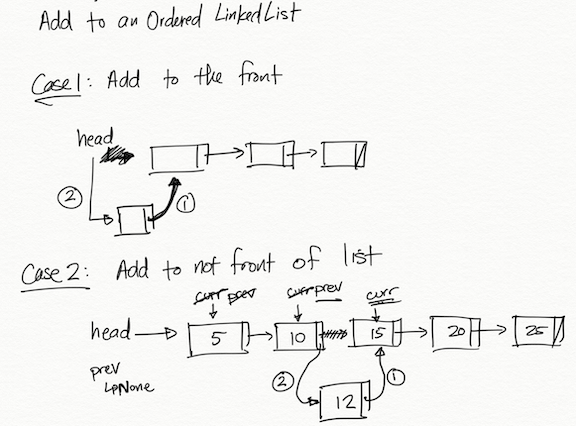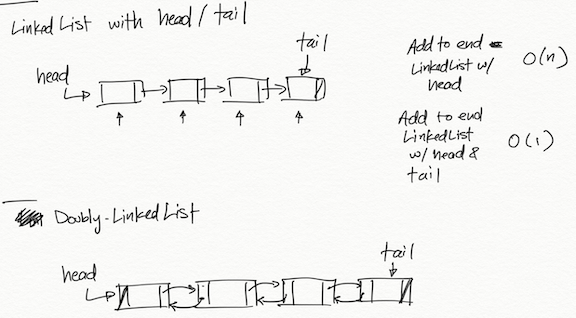| Previous Lecture | Lecture 11 | Next Lecture |
Lecture 11, Tue 05/09
Linked Lists cont., Quadratic Sorting Algorithms
Recorded Lecture: 5_9_23
Pytests for the Linked List Implementation
#LinkedListTest.py
from LinkedList import LinkedList, Node
def test_NodeCreation():
n = Node(20)
assert n.getData() == 20
assert n.getNext() == None
def test_NodeSetData():
n = Node(20)
n.setData(200)
assert n.getData() == 200
def test_NodeSetNext():
n = Node(20)
n2 = Node(10)
n.setNext(n2)
assert n.getNext() == n2
def test_createList():
ll = LinkedList()
assert ll.isEmpty() == True
def test_addingNodesToList():
ll = LinkedList()
assert ll.isEmpty() == True
ll.addToFront(10)
ll.addToFront("Gaucho")
ll.addToFront(False)
assert ll.isEmpty() == False
assert ll.length() == 3
assert ll.search(10) == True
assert ll.search("Gaucho") == True
assert ll.search(False) == True
assert ll.search("CS9") == False
def test_removeNodesFromList():
ll = LinkedList()
ll.addToFront(10)
ll.addToFront("Gaucho")
ll.addToFront(False)
ll.addToFront("CS9")
assert ll.length() == 4
assert ll.search(10) == True
ll.remove(10)
assert ll.search(10) == False
assert ll.search("Gaucho") == True
assert ll.search(False) == True
assert ll.search("CS9") == True
assert ll.length() == 3
ll.remove(False)
assert ll.search(False) == False
assert ll.search("Gaucho") == True
assert ll.search("CS9") == True
assert ll.length() == 2
assert ll.isEmpty() == False
ll.remove("Gaucho")
ll.remove("CS9")
ll.isEmpty() == True
ll.length() == 0
Ordered Linked Lists
- We’ve discussed Unordered Linked Lists where the position of the nodes did not matter with respect to each other
- An Ordered Linked List is similar to an Unordered Linked List except (as you might guess) the nodes in the list are ordered with respect to each other
- The implementation of both are similar, except we have to maintain the ordered property of the nodes when we manage the list
- Most methods can be the same, but adding the node requires us to put a node in the correct position (instead of simply adding to the front of the list)
- Consider two cases:
- Adding to the front of the Linked List
- Adding to the middle / end of the Linked List

- Let’s implement the
addmethod to see what inserting an item in the middle of the list would look like- Note: I did this in the
LinkedListclass, but it would be better to implement this in anOrderedLinkedListclass. I did this because I’ll only test theaddmethod with sorted elements in the Linked List.
- Note: I did this in the
# add method to maintain an Ordered Linked List
def add(self, item):
current = self.head
previous = None
stop = False
# find the correct place in the list to add
while current != None and not stop:
if current.getData() > item:
stop = True
else:
previous = current
current = current.getNext()
# create Node with item to add
temp = Node(item)
# Case 1: insert at the front of the list
if previous == None:
temp.setNext(self.head)
self.head = temp
else: # Case 2: insert not at front of list
temp.setNext(current)
previous.setNext(temp)
# Method to get the items from front to back
def getList(self):
current = self.head
output = ""
while current != None:
output += str(current.getData()) + " "
current = current.getNext()
output = output[:len(output)-1] # remove end space
return output
# Test to check if adding elements maintain order
def test_insertIntoOrderedList():
ll = LinkedList()
ll.add(35)
ll.add(50)
ll.add(10)
ll.add(40)
ll.add(20)
ll.add(30)
assert ll.getList() == \
"10 20 30 35 40 50"
ll.add(5)
assert ll.getList() == \
"5 10 20 30 35 40 50"
ll.add(60)
assert ll.getList() == \
"5 10 20 30 35 40 50 60"
- Note that there are many variations on maintaining Linked Lists
- Some variations improve the performance on certain methods
- Examples:
- Linked List with head AND tail references
- Double-Linked List
- Circular Linked List
- etc.
- Depending on what you need the data structure for, you can design variations to possibly improve your application

Quadratic Sorting Algorithms
- So far, we’ve discussed some ways of searching through a list
- Linear search - start at the beginning and check every element in the list
- Does not require elements to be sorted
- O(n) complexity
- Binary search - check the middle, then check left or right sub lists
- Does require elements to be sorted
- O(log n) complexity
- Linear search - start at the beginning and check every element in the list
- But we haven’t discussed HOW to sort an unordered list
- There are many ways to do this, and some approaches are better than others (for example, Bogosort is pretty bad! https://en.wikipedia.org/wiki/Bogosort). We’ll discuss several sorting algorithms and analyze their performance
- Quadratic Sorting Algorithms are done in O(n2)
Bubble Sort
Idea: Bubble sort will make several passes through the list and swap adjacent elements to ensure the largest element ends up at the end of the list (assuming we’re sorting in ascending order)
def bubbleSort(aList):
for passnum in range(len(aList)-1,0,-1):
for i in range(passnum):
if aList[i] > aList[i+1]:
# swap (bubble up!)
temp = aList[i]
aList[i] = aList[i+1]
aList[i+1] = temp
# Bubble sort pytest
def test_bubbleSort():
list1 = [1,2,3,4,5,6]
list2 = [2,2,2,2,2,2]
list3 = []
list4 = [6,7,5,3,1]
bubbleSort(list1)
assert list1 == [1,2,3,4,5,6]
bubbleSort(list2)
assert list2 == [2,2,2,2,2,2]
bubbleSort(list3)
assert list3 == []
bubbleSort(list4)
assert list4 == [1,3,5,6,7]
Bubble Sort Analysis
- Notice that we have to make at most n-1 comparisons during the first iteration through the list
- Then n-2 comparisons during the 2nd iteration, etc.
- So if count the number of comparisons in this algorithm, we have
- 1 + 2 + 3 + … + (n-2) + (n-1)
- This summation can be simplified to n(n+1)/2
- We can deduce that this algorithm is O(n2)
- Also note that in the BEST case scenario, the list is already sorted
- Each iteration does nothing, but we still compare the values anyways, thus performing unnecessary work
- In order to improve situations where the list becomes sorted during the swaps, we can check if a swap occurred during an iteration
- If yes, continue algorithm
- If no, then the list is sorted, so stop the algorithm!
- An implementation of this optimization is shown in the textbook